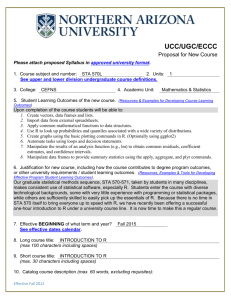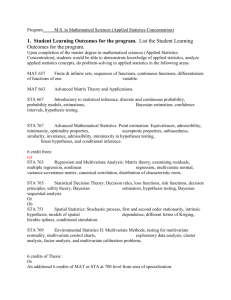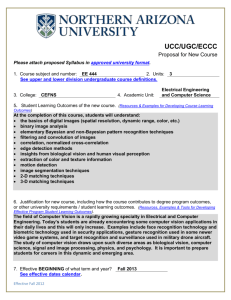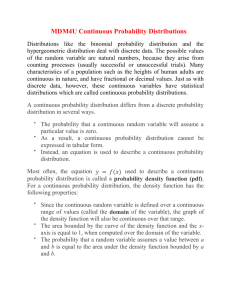STA 475 - nau.edu
advertisement
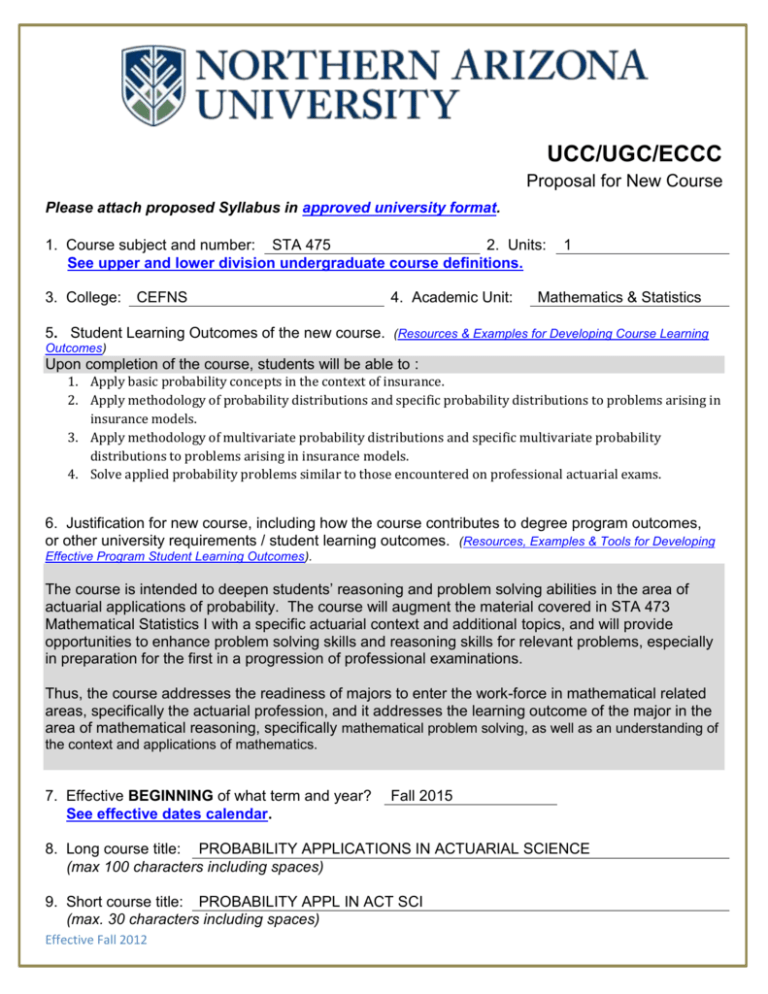
UCC/UGC/ECCC Proposal for New Course Please attach proposed Syllabus in approved university format. 1. Course subject and number: STA 475 2. Units: See upper and lower division undergraduate course definitions. 3. College: CEFNS 4. Academic Unit: 1 Mathematics & Statistics 5. Student Learning Outcomes of the new course. (Resources & Examples for Developing Course Learning Outcomes) Upon completion of the course, students will be able to : 1. Apply basic probability concepts in the context of insurance. 2. Apply methodology of probability distributions and specific probability distributions to problems arising in insurance models. 3. Apply methodology of multivariate probability distributions and specific multivariate probability distributions to problems arising in insurance models. 4. Solve applied probability problems similar to those encountered on professional actuarial exams. 6. Justification for new course, including how the course contributes to degree program outcomes, or other university requirements / student learning outcomes. (Resources, Examples & Tools for Developing Effective Program Student Learning Outcomes). The course is intended to deepen students’ reasoning and problem solving abilities in the area of actuarial applications of probability. The course will augment the material covered in STA 473 Mathematical Statistics I with a specific actuarial context and additional topics, and will provide opportunities to enhance problem solving skills and reasoning skills for relevant problems, especially in preparation for the first in a progression of professional examinations. Thus, the course addresses the readiness of majors to enter the work-force in mathematical related areas, specifically the actuarial profession, and it addresses the learning outcome of the major in the area of mathematical reasoning, specifically mathematical problem solving, as well as an understanding of the context and applications of mathematics. 7. Effective BEGINNING of what term and year? See effective dates calendar. Fall 2015 8. Long course title: PROBABILITY APPLICATIONS IN ACTUARIAL SCIENCE (max 100 characters including spaces) 9. Short course title: PROBABILITY APPL IN ACT SCI (max. 30 characters including spaces) Effective Fall 2012 10. Catalog course description (max. 60 words, excluding requisites): Application of probability concepts and methods suitable for preparation for careers in the actuarial profession. Use of random variables, distribution theory, specific probabilistic distributions, expected value, and related concepts in insurance models including deductibles, caps, premiums, and loss. Letter grade only. Prerequisite or Corequisite: STA 473. 11. Will this course be part of any plan (major, minor or certificate) or sub plan (emphasis)? Yes If yes, include the appropriate plan proposal. No The course will not be required in any program, but it will count as elective hours toward the total requirements of the BS in Mathematics. 12. Does this course duplicate content of existing courses? Yes No If yes, list the courses with duplicate material. If the duplication is greater than 20%, explain why NAU should establish this course. The course will draw on material developed in STA 473 Mathematical Statistics I, but it will primarily be focused on applying the content of that course in the actuarial context, and therefore the new course is substantially different than STA 473. 13. Will this course impact any other academic unit’s enrollment or plan(s)? Yes No If yes, describe the impact. If applicable, include evidence of notification to and/or response from each impacted academic unit 14. Grading option: Letter grade Pass/Fail Both 15. Co-convened with: 14a. UGC approval date*: (For example: ESE 450 and ESE 550) See co-convening policy. *Must be approved by UGC before UCC submission, and both course syllabi must be presented. 16. Cross-listed with: (For example: ES 450 and DIS 450) See cross listing policy. Please submit a single cross-listed syllabus that will be used for all cross-listed courses. 17. May course be repeated for additional units? 16a. If yes, maximum units allowed? 16b. If yes, may course be repeated for additional units in the same term? 18. Prerequisites: STA 473 If prerequisites, include the rationale for the prerequisites. The course relies heavily on the content and methodology of STA 473. 19. Co requisites: STA 473 If co requisites, include the rationale for the co requisites. Effective Fall 2012 Yes No Yes No The course relies heavily on the content and methodology of STA 473. 20. Does this course include combined lecture and lab components? Yes If yes, include the units specific to each component in the course description above. 21. Names of the current faculty qualified to teach this course: No Art DeGraw, John Hagood 22. Classes scheduled before the regular term begins and/or after the regular term ends may require additional action. Review “see description” and “see impacts” for “Classes Starting/Ending Outside Regular Term” under the heading “Forms” http://nau.edu/Registrar/Faculty-Resources/Schedule-of-Classes-Maintenance/. Do you anticipate this course will be scheduled outside the regular term? Yes No 23. Is this course being proposed for Liberal Studies designation? If yes, include a Liberal Studies proposal and syllabus with this proposal. Yes No 24. Is this course being proposed for Diversity designation? If yes, include a Diversity proposal and syllabus with this proposal. Yes Answer 22-23 for UCC/ECCC only: FLAGSTAFF MOUNTAIN CAMPUS Reviewed by Curriculum Process Associate Date Approvals: Department Chair/Unit Head (if appropriate) Date Chair of college curriculum committee Date Dean of college Date For Committee use only: UCC/UGC Approval Effective Fall 2012 Date No Approved as submitted: Yes No Approved as modified: Yes No EXTENDED CAMPUSES Reviewed by Curriculum Process Associate Date Approvals: Academic Unit Head Date Division Curriculum Committee (Yuma, Yavapai, or Personalized Learning) Date Division Administrator in Extended Campuses (Yuma, Yavapai, or Personalized Learning) Date Faculty Chair of Extended Campuses Curriculum Committee (Yuma, Yavapai, or Personalized Learning) Date Chief Academic Officer; Extended Campuses (or Designee) Date Approved as submitted: Yes No Approved as modified: Yes No Effective Fall 2012 Department of Mathematics & Statistics Adel Mathematics Building PO Box 5717 Flagstaff, AZ 86011-5717 928-523-3481 928-523-5847 fax www.math.nau.edu STA 475 Probability Applications in Actuarial Science Fall 2015 Instructor: Dr. Art DeGraw Office: Adel Mathematics 119 Office Hours: Course Description and Prerequisites. (1 credit hour) Application of probability concepts and methods suitable for preparation for careers in the actuarial profession. Use of random variables, distribution theory, specific probabilistic distributions, expected value, and related concepts in insurance models including deductibles, caps, premiums, and loss. Letter grade only. Prerequisite or Corequisite: STA 473. Meets weekly for a total of 15 hours during the term. Student Learning Outcomes Upon completion of the course, students will be able to : 1. Apply basic probability concepts in the context of insurance. 2. Apply methodology of probability distributions and specific probability distributions to problems arising in insurance models. 3. Apply methodology of multivariate probability distributions and specific multivariate probability distributions to problems arising in insurance models. 4. Solve applied probability problems similar to those encountered on professional actuarial exams. Course structure/approach. A small portion of the class meetings will be devoted to introducing terminology and concepts related to insurance. For most of the term, students will be given weekly assignments of problems applying probability theory to insurance models, and class sessions will be devoted to working through a portion of the assigned problems. The content is not arranged in a linear order but rather is driven by problem collections that may draw on any of the concepts and methods at any point in the term. Textbook and required materials 1. Text: free for academic use – A Probability Course for the Actuaries: A Preparation for Exam P/1, Marcel B. Finan (http://faculty.atu.edu/mfinan/actuarieshall/Pbook.pdf) 2. Society of Actuaries Exam P Sample Problems: (http://www.beanactuary.org/exams/preliminary/exams/syllabi/ExamPSamplequestions.pdf) 3. Society of Actuaries approved calculator, currently Texas Instruments TI–30Xa or TI–30X II* (IIS solar or IIB battery), or TI-30X MultiView (XS Solar or XB Battery) (see: http://www.soa.org/education/exam-req/exam-day-info/edu-calculators.aspx) Effective Fall 2012 Course Outline 1. Terminology and insurance models (one week) 2. Practice in applying probability to actuarial science and insurance models drawing on basic probability theory and methods covered in STA 473. (fourteen weeks) The topics covered in the presentation and applied in problems include: a. Risk and Insurance: Basic notions, limits, deductibles, inflation, continuous severity. b. General probability (applied to insurance): basic concepts including Bayes theorem. c. Univariate distributions, especially binomial, negative binomial, geometric, hypergeometric, Poisson, uniform, exponential, gamma, normal: mass and density functions, cumulative distribution function, variance, moment generating functions, transformation d. Multivariate distributions (including the bivariate normal): joint mass and density functions, joint cumulative distribution functions, Central Limit Theorem, conditional and marginal distributions, moments, joint moment generating functions, variance for marginal and conditional distributions, covariance and correlation, transformation and order statistics, linear combinations of random variables Assessment of Student Learning Outcomes In addition to a comprehensive final exam, there will be weekly homework assignments and frequent short quizzes. These will be weighted as follows. Homework and quizzes: 70% Final Exam: 30% Grading System Grades will be based on percentages as follows. A: 90 – 100%; B: 80 – 89%; C: 70 – 79%; D: 60 – 69%; F: 0 – 59% Course policies Make-up quizzes will only be given with sufficient reasons for missing in the judgment of the instructor. University policies: Attach the Safe Working and Learning Environment, Students with Disabilities, Institutional Review Board, and Academic Integrity policies or reference them on the syllabus. See the following document for policy statements: http://nau.edu/OCLDAA/_Forms/UCC/SyllabusPolicyStmts2-2014/ Effective Fall 2012
